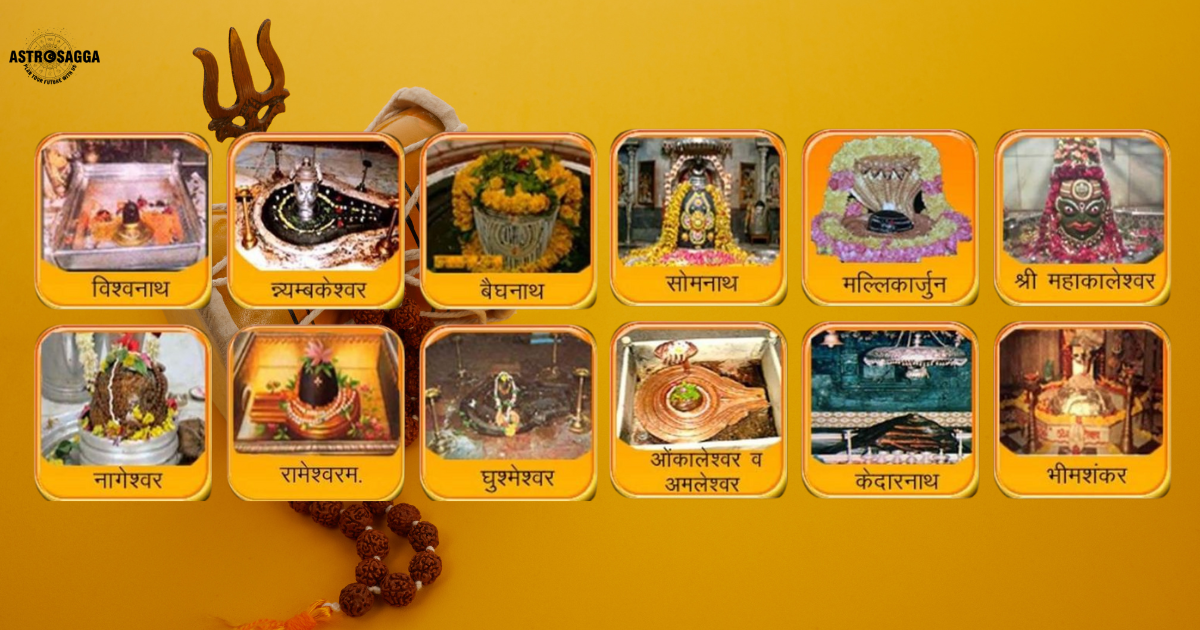India is a land of profound spirituality and ancient traditions. Among its many religious treasures, the Jyotirlingas hold a special place in the hearts of devotees of Lord Shiva. The term "Jyotirlinga" translates to "radiant sign of Shiva," and these sacred shrines are considered manifestations of Shiva's pure, divine light. According to Hindu tradition, there are 12 such Jyotirlingas scattered across the country, each with its unique significance, legend, and charm.
In this blog, we will explore the 12 Jyotirlingas, their names and places, and the legends associated with them. We'll also delve into the spiritual importance of visiting these temples, offering a comprehensive guide for devotees and travelers alike.
1. Somnath Jyotirlinga - Prabhas Patan, Gujarat
The Somnath Temple, located in Prabhas Patan near Veraval in Saurashtra, Gujarat, is considered the first among the 12 Jyotirlingas. It is believed that the Moon God, Chandra, built the temple to honor Lord Shiva, who cured him of a curse that caused waning. This temple has been destroyed and rebuilt several times throughout history, symbolizing the resilience of faith.
2. Mallikarjuna Jyotirlinga - Srisailam, Andhra Pradesh
Situated on the Shri Shaila Mountain by the Krishna River in Andhra Pradesh, the Mallikarjuna Jyotirlinga is revered as a significant pilgrimage site. It is associated with the story of Shiva and Parvati visiting this place to bless their son Kartikeya, who had chosen it as his abode.
3. Mahakaleshwar Jyotirlinga - Ujjain, Madhya Pradesh
The Mahakaleshwar Temple in Ujjain is renowned for its unique feature of the Shiva lingam facing south, known as dakshinamukhi. This temple, set on the banks of the Kshipra River, is considered particularly powerful, as it is believed to be Swayambhu (self-manifested). Devotees believe that worshipping here can prevent untimely death and grant liberation.
4. Omkareshwar Jyotirlinga - Mandhata Island, Madhya Pradesh
The Omkareshwar Temple is located on Mandhata Island in the Narmada River, Madhya Pradesh. The island's shape is said to resemble the sacred symbol 'Om'. This Jyotirlinga is unique because it is divided into two temples: Omkareshwar and Mamleshwar (Amleshwar), symbolizing the dual nature of the divine.
5. Kedarnath Jyotirlinga - Kedarnath, Uttarakhand
Nestled in the Himalayas, the Kedarnath Temple is one of the most revered Jyotirlingas. It is part of the Char Dham pilgrimage and is accessible only during certain months due to extreme weather conditions. The temple is believed to have been established by the Pandavas to atone for their sins after the Mahabharata war.
6. Bhimashankar Jyotirlinga - Pune, Maharashtra
Located in the Sahyadri hills of Maharashtra, the Bhimashankar Temple is associated with the legend of Shiva slaying the demon Tripurasura. The temple is surrounded by dense forests, making it a picturesque yet spiritually significant destination.
7. Kashi Vishwanath Jyotirlinga - Varanasi, Uttar Pradesh
The Kashi Vishwanath Temple in Varanasi, also known as Banaras, is one of the most famous temples in India. It is said that a visit to this temple and a dip in the holy Ganges River can grant liberation (moksha). The temple has been a beacon of faith for millions and has faced numerous attacks and reconstructions over centuries.
8. Trimbakeshwar Jyotirlinga - Nashik, Maharashtra
Situated near the city of Nashik in Maharashtra, the Trimbakeshwar Temple is unique as it has three faces representing Brahma, Vishnu, and Shiva. It is located at the source of the Godavari River, which holds immense religious significance. The temple is also a part of the famous Kumbh Mela pilgrimage.
9. Vaidyanath Jyotirlinga - Deoghar, Jharkhand
The Vaidyanath Temple, also known as Baba Dham, is located in Deoghar, Jharkhand. It is believed that worshipping at this temple with full devotion can relieve one from various diseases and ailments. The temple complex is a significant pilgrimage site, attracting millions of devotees during the Shravana month.
10. Nageshwar Jyotirlinga - Dwarka, Gujarat
The Nageshwar Temple near Dwarka in Gujarat is one of the 12 Jyotirlingas and is mentioned in the Shiva Purana. The temple is associated with the legend of the demon Daruka, who was defeated by Lord Shiva. The Shiva lingam here is unique as it faces south and is believed to protect devotees from poison and evil influences.
11. Rameshwar Jyotirlinga - Rameswaram, Tamil Nadu
The Rameshwar Temple, located on the island of Rameswaram in Tamil Nadu, is one of the Char Dham pilgrimages in Hinduism. It is believed that Lord Rama built the temple to worship Shiva and seek his blessings before crossing over to Lanka. The temple is known for its intricate architecture and the longest corridor among all Hindu temples.
12. Grishneshwar Jyotirlinga - Ellora, Maharashtra
The Grishneshwar Temple is situated near the Ellora Caves in Maharashtra. It is the last of the 12 Jyotirlingas and is also known as Ghushmeshwar. The temple is relatively smaller but holds immense spiritual significance, with legends describing its restoration by a devotee named Kusuma.
Spiritual Significance of the Jyotirlingas
Visiting the 12 Jyotirlingas is considered highly auspicious for devotees of Lord Shiva. Each temple has its unique legend and significance, but collectively, they represent the infinite power and benevolence of Shiva. It is believed that undertaking a pilgrimage to these temples can cleanse one of sins, grant spiritual enlightenment, and ensure liberation from the cycle of birth and death.
The Jyotirlinga Mantra
The Jyotirlinga mantra is a powerful invocation chanted by devotees to seek blessings from Lord Shiva. It goes as follows:
- Saurashtre Somanatham Cha Shrishaile Mallikarjunam,
- Ujjayinyam Mahakalam Omkaram Mamaleshwaram,
- Kedaram Himavatprashte Dakinyam Bhimashankaram,
- Varanasyam Cha Vishwesham Tryambakam Gautamitate,
- Paralyam Vaidyanatham Cha Nagesham Darukavane,
- Setubandhe Tu Ramesham Grishnesham Shivalaye,
- Etani Jyotirlingani Sayam Praatah Pathennarah,
- Sapta Janma Kritam Punyam Smaranena Vinashyati.
Chanting this mantra with devotion is believed to invoke the blessings of Lord Shiva and provide spiritual protection and prosperity.
Conclusion
The 12 Jyotirlingas are not just temples but are epicenters of faith, spirituality, and divine energy. Each Jyotirlinga has a unique story that adds to its significance, drawing millions of devotees from around the world. Visiting these temples is not merely a pilgrimage but a journey towards spiritual awakening and inner peace. Whether you are a devout follower or a curious traveler, the Jyotirlingas offer a profound connection to India's rich spiritual heritage and the timeless worship of Lord Shiva.












